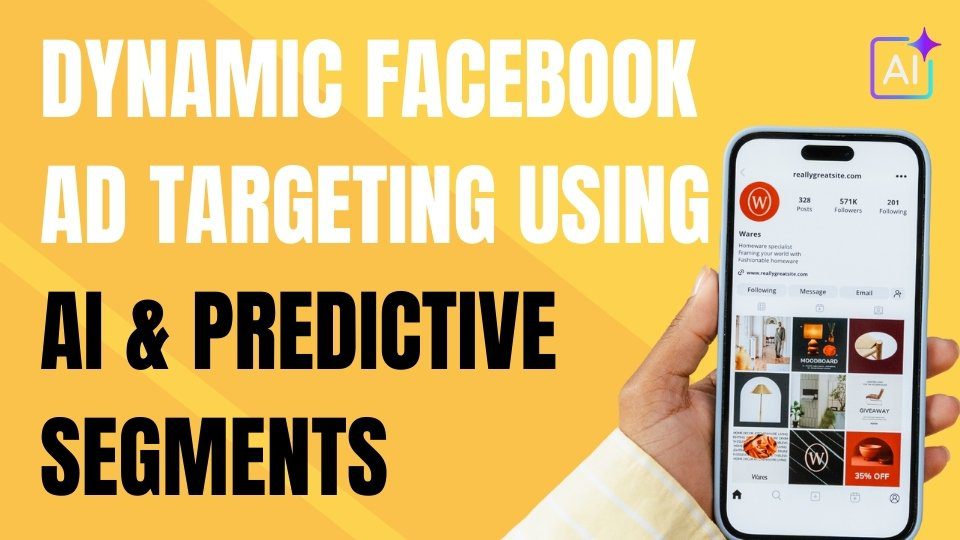AI Learning Centres:
- AI – Learn The Basics
- Get The Most From ChatGPT
- Branding in The Age of AI
- AI for Client Experience
- AI For Prospecting
- AI For Marketing
- AI For Listings & Ads
- Team Adoption of AI
- AI For PM
- AIO & Generative Search
- AI For Operations & Efficiency
- AI For Market Research & Analysis
- AI Ethics, Privacy & Compliance in Real Estate
Digital Marketing & Social Media Learning Centres:
Guides & Downloads

Dynamic Facebook Ad Targeting Using AI & Predictive Segments
Facebook’s ad system no longer needs you to guess who should see each listing or campaign. Its built-in artificial intelligence (AI) studies real-time signals, location, browsing history, and even how long someone watches a property video and shows the ad to people most likely to take action.
For real-estate, that means more vendor leads, more buyers at open homes, and less wasted spend.
How Facebook’s AI Finds the Right Audience
Advantage+ automation: Meta’s Advantage+ tools let you set a clear goal (e.g. “Generate seller leads”) while AI handles placements, bidding, and micro-targeting. The system keeps learning every time someone clicks, submits a form, or books a viewing.
Predictive audiences: Facebook can now build “look-ahead” audiences—people who haven’t interacted with you but show similar patterns to past high-value clients.
Dynamic creative: AI automatically mixes headlines, images, and calls-to-action until it finds the winning combo for each micro-segment.
Step 1: Collect First-Party Data
Before AI can predict who will act, feed it the right data:
Pixel and Conversions API on your website for page views, enquiry forms, and market-report downloads.
CRM uploads of recent buyers, sellers, and appraisal requests (hashed for privacy).
Offline events such as calls booked or contracts signed.
Tip: The richer the data, the smarter Facebook’s predictions. A simple CSV export from your CRM each week keeps segments fresh.
Step 2: Build Predictive Segments
Use your CRM or an AI scoring tool to label contacts. For example:
Ready Sellers – requested a free appraisal, visited “What’s my home worth?” page 3+ times this month.
Upsizers – clicked family-sized homes over $1 million and saved schools in search filters.
Investors – downloaded rental yield guide, spent 5+ minutes on property-management page.
Export each group as a Custom Audience. Facebook’s AI then finds “lookalikes” who share the same digital fingerprints—even if they’ve never met you.
Step 3: Create Dynamic Facebook Ads
Choose “Special Ad Category: Housing” to stay compliant with anti-discrimination rules.
Link a catalog feed (a Google Sheet or XML) of current listings.
Turn on dynamic formats and creative. Facebook swaps in the right photo, price, and suburb for each viewer automatically.
Write one evergreen primary text block—AI pairs it with different images and headlines to match each person’s intent.
Step 4: Activate Advantage+ Audiences
Inside Ads Manager, pick Advantage+ Audience (or Advantage+ Appointments if your goal is inspection bookings). Tell Facebook your broad market area – say, “within 15 km of postcode 4000.” The system layers in its own predicted interest and behaviour signals to reach the hottest prospects for you in real time.
Step 5: Test and Optimise
Use A/B tests to compare a dynamic ad group versus a manually targeted one for two weeks.
Watch Cost Per Lead (CPL) and Quality Ranking metrics, not just clicks.
Refresh the catalog weekly so the AI never serves an old or sold property.
Exclude recent converters to avoid wasting impressions on clients who have already bought or listed.
Compliance & Privacy Checklist
Obtain clear consent before uploading client data; follow the Privacy Act 1988 and Meta’s Custom Audience Terms.
Use “Special Ad Category: Housing” to avoid filters such as age, gender, or postcode targeting below 15 km.
Provide an easy opt-out link in every lead form and email nurture sequence.
Quick-Start Checklist
Install Facebook Pixel + Conversions API.
Sync CRM segments (Ready Sellers, Upsizers, Investors).
Build a listings catalog feed.
Launch one Advantage+ campaign per segment goal.
Review CPL and lead quality every seven days.
Iterate creative with new headlines and fresh property photos.
Dynamic Facebook ads powered by AI remove much of the manual tinkering that once made digital marketing feel complex. By pairing your own predictive segments with Meta’s real-time optimisation, you reach people who actually need your expertise today—whether that’s a family upsizing to a bigger backyard or an owner ready to list this spring.
Start small, feed the machine good data, and let the AI earn its keep while you focus on closing the next deal.
Author – Ken Hobson.






